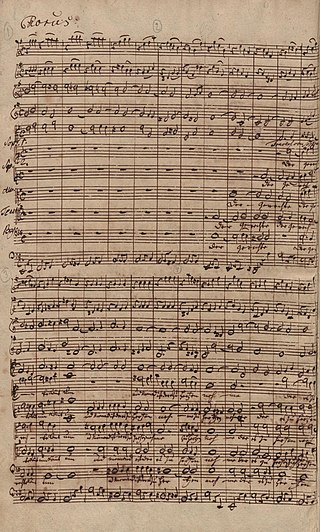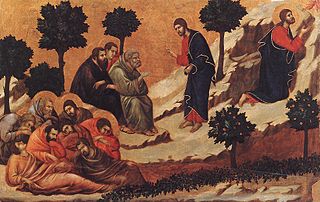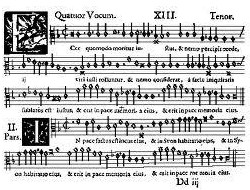
Johann Ludwig Bach was a German composer and violinist.

Johann Kuhnau was a German polymath, known primarily as a composer today. He was also active as a novelist, translator, lawyer, and music theorist, and was able to combine these activities with his duties in his official post as Thomaskantor in Leipzig, which he occupied for 21 years. Much of his music, including operas, masses, and other large-scale vocal works, is lost. His reputation today rests on his Biblical Sonatas, a set of programmatic keyboard sonatas published in 1700, in which each sonata depicted in detail a particular story from the Bible. After his death, Kuhnau was succeeded as Thomaskantor by Johann Sebastian Bach.

Jesu, meine Freude, BWV 227, is a motet by Johann Sebastian Bach. The longest and most musically complex of Bach's motets, it is set in eleven movements for up to five voices. It is named after the Lutheran hymn "Jesu, meine Freude" with words by Johann Franck, first published in 1653. The motet contains the six stanzas of the hymn in its odd-numbered movements. The hymn tune by Johann Crüger appears in all of these movements in different styles of chorale settings. The text of the motet's even-numbered movements is taken from the eighth chapter of the Epistle to the Romans, a passage that influenced key Lutheran teachings. The hymn, written in the first person with a focus on an emotional bond with Jesus, forms a contrasting expansion of the doctrinal biblical text. Bach set both texts alternating with and complementing each other, in a structure of symmetries on different layers.

Johann Sebastian Bach's Magnificat, BWV 243, is a musical setting of the biblical canticle Magnificat. It is scored for five vocal parts, and a Baroque orchestra including trumpets and timpani. It is the first major liturgical composition on a Latin text by Bach.

Singet dem Herrn ein neues Lied, BWV 225, is a motet by Johann Sebastian Bach. It was first performed in Leipzig around (probably) 1727. The text of the three-movement motet is in German: after Psalm 149 for its first movement, the third stanza of "Nun lob, mein Seel, den Herren" for the second movement, and after Psalm 150:2 and 6 for its third movement Psalms 150:2,6.

Uns ist ein Kind geboren, BWV 142 / Anh. II 23, is a Christmas cantata by an unknown composer. In the Bach-Werke-Verzeichnis it is listed among the works with a doubtful attribution to Johann Sebastian Bach. The text is based on a libretto by Erdmann Neumeister first published in 1711. Although attributed to Bach by the Bach-Gesellschaft when they first published it in the late nineteenth century, that attribution was questioned within thirty years and is no longer accepted. Johann Kuhnau, Bach's predecessor as Thomaskantor in Leipzig, has been suggested as the probable composer, but without any certainty.
Most of Johann Sebastian Bach's extant church music in Latin—settings of the Mass ordinary and of the Magnificat canticle—dates from his Leipzig period (1723–50). Bach started to assimilate and expand compositions on a Latin text by other composers before his tenure as Thomaskantor in Leipzig, and he continued to do so after he had taken up that post. The text of some of these examples by other composers was a mixture of German and Latin: also Bach contributed a few works employing both languages in the same composition, for example his early Kyrie "Christe, du Lamm Gottes".
As Thomaskantor, Johann Sebastian Bach provided Passion music for Good Friday services in Leipzig. The extant St Matthew Passion and St John Passion are Passion oratorios composed by Bach.

Jesus Christus ist um unsrer Missetat willen verwundet is a St Mark Passion which originated in the early 18th century and is most often attributed to Reinhard Keiser. It may also have been composed by his father Gottfried or by Friedrich Nicolaus Bruhns. Johann Sebastian Bach produced three performance versions of the Passion, the last of which is a pasticcio with arias from George Frideric Handel's Brockes Passion. There are two other extant 18th-century versions of the Passion, both of them independent of Bach's versions. The Passion was performed in at least three cities in the first half of the 18th century: in Hamburg in 1707 and 1711, in Weimar around 1712, and in Leipzig in 1726 and around 1747.

Christen, ätzet diesen Tag, BWV 63, is a church cantata by Johann Sebastian Bach. He composed the Christmas cantata for the First Day of Christmas, possibly in 1713 for the Liebfrauenkirche in Halle. He performed it again for his first Christmas as Thomaskantor in Leipzig, on 25 December 1723.

The Magnificat in E-flat major, BWV 243a, also BWV 243.1, by Johann Sebastian Bach is a musical setting of the Latin text of the Magnificat, Mary's canticle from the Gospel of Luke. It was composed in 1723 and is in twelve movements, scored for five vocal parts and a Baroque orchestra of trumpets, timpani, oboes, strings and basso continuo including bassoon. Bach revised the work some ten years later, transposing it from E-flat major to D major, and creating the version mostly performed today, BWV 243.
Tristis est anima mea is the Latin phrase with which Matthew 26:38 starts. It is Tristis est anima mea (responsory), the second responsory of the Tenebrae for Maundy Thursday which was often set to music. It may also refer to:

Wer ist der, so von Edom kömmt is a pasticcio Passion oratorio based on compositions by Carl Heinrich Graun, Georg Philipp Telemann, Johann Sebastian Bach and others. The pasticcio was assembled around 1750.

Tristis est anima mea is the second responsory of the Tenebrae for Maundy Thursday. The Latin text refers to Christ's Agony in the Garden of Gethsemane, a part of his Passion.

The righteous perishes are the words with which the 57th chapter of the Book of Isaiah starts. In Christianity, Isaiah 57:1–2 is associated with the death of Christ, leading to liturgical use of the text at Tenebrae: the 24th responsory for Holy Week, "Ecce quomodo moritur justus", is based on this text. More generally, the text is associated with the death of loved ones and is used at burials. As such, and in other versions and translations, the Bible excerpt has been set to music.

Der Gerechte kömmt um, BWV 1149, is a motet for SSATB singers and instrumental ensemble, which, for its music, is based on the five-part a cappella motet Tristis est anima mea attributed to Johann Kuhnau, and has the Luther Bible translation of Isaiah 57:1–2 as text. The arrangement of the Latin motet, that is, transposing it to E minor, adjusting its music to the new text, and expanding it with an instrumental score for two traversos, two oboes, strings and basso continuo, is attributed to Johann Sebastian Bach. The setting is found in a manuscript copy, likely written down in the 1750s, of Wer ist der, so von Edom kömmt, a Passion oratorio which is a pasticcio based on compositions by, among others, Carl Heinrich Graun, Georg Philipp Telemann and Bach. Likely Der Gerechte kömmt um existed as a stand-alone motet, for example for performance on Good Friday or at a funeral, before being adopted in the pasticcio.

Wie lieblich sind deine Wohnungen is a sacred motet for four voices that Johann Hermann Schein, Thomaskantor in Leipzig, composed in 1628, setting verses 2–4 of Psalm 84 in German.















